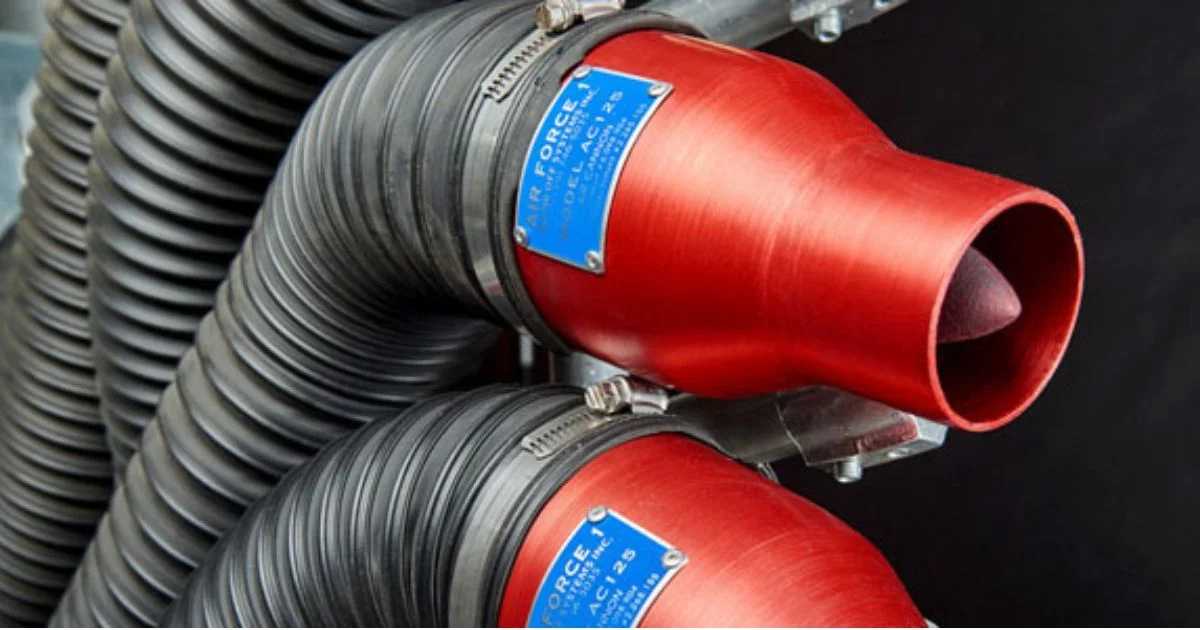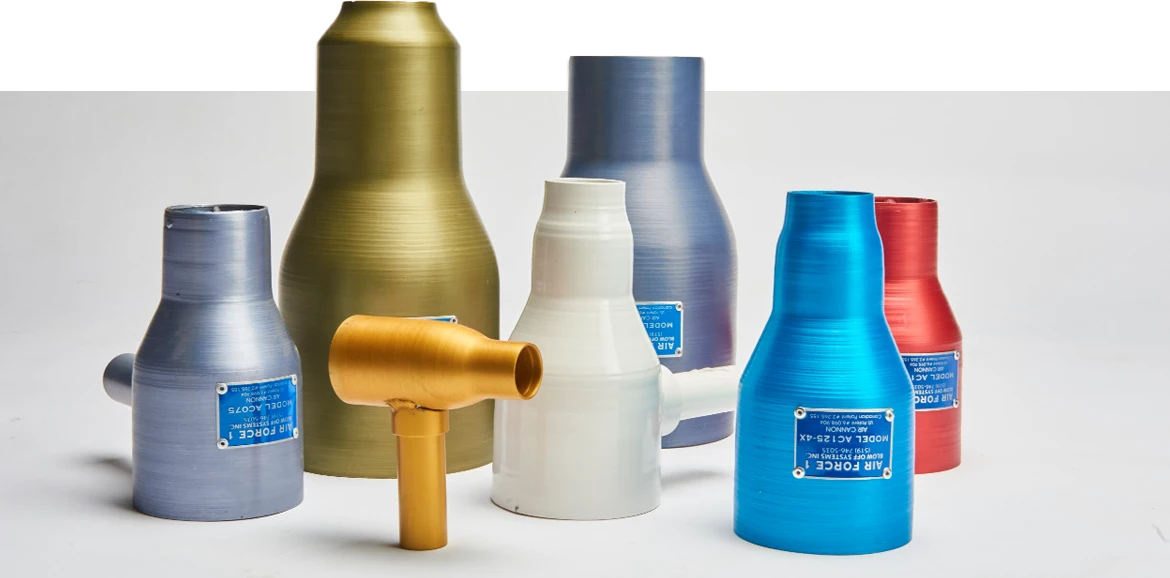
Moisture left behind is money left behind. Manufacturing teams often discover how quickly drying problems can shut down production lines. Choosing the wrong air cannon nozzle frequently causes these costly delays – a persistent challenge for automotive, electronics, food packaging, and pharmaceutical manufacturers who may never identify the real source of their troubles.
Drying issues affect more than just production speed. Poor moisture removal leads to quality defects, wasted energy, and missed delivery schedules. Many plants don't recognize that their nozzle selection – a seemingly minor detail – might be undermining their entire operation. Even experienced engineers sometimes overlook this critical system component.
This guide breaks down air cannon nozzle selection in practical terms. You'll learn the specific situations where single versus multiple outlet nozzles perform best, how proper sizing significantly impacts results, and when air knives might actually be the superior solution.
Understanding Air Cannon Nozzles
Air cannon nozzles, also called industrial drying nozzles, deliver focused, high-velocity air for precise cleaning and drying. Unlike compressed air, these nozzles typically work with blower systems that provide steadier airflow while using less energy and costing less to run.
Inside the nozzle, engineered channels transform air pressure into concentrated force. Some models include accelerator inserts that boost speed and impact. These features make air cannon nozzles ideal for removing shot after peening, drying deep spots in machined parts, cleaning assembly components, or blasting debris from hard-to-reach areas.
Choosing the right nozzle can greatly improve results, potentially cutting air use by half while cleaning better. For some jobs, especially when drying wider surfaces, an air knife might work better than a cannon nozzle.
Most air cannon nozzles have three main parts: the inlet connecting to your air supply, the body containing any acceleration features, and the outlet where fast-moving air emerges. They come in different materials: anodized aluminum for everyday use, stainless steel for harsh environments or food applications, and specialty polymers when you can't risk marking sensitive products. Many suppliers offer custom configurations to match specific requirements.
Single vs. Multiple Outlet Nozzles
Single Outlet Nozzles
Single outlet nozzles focus all air energy into one stream, giving you maximum impact force. They work best for:
Cleaning deep, narrow spaces
Drying tight spots in complex parts
Removing stubborn dirt from specific areas
Clearing out individual channels or holes
The best single outlet nozzles have smooth internal shapes that reduce turbulence and pressure loss. Some advanced models let you adjust the focus, changing from a tight, concentrated blast to a slightly wider pattern without switching nozzles.
Bigger nozzles aren't always better. Cleaning effectiveness depends more on airflow speed and nozzle fit than size alone. A smaller, well-designed nozzle often cleans better than a larger one when you need precision and focused impact.
Multiple Outlet Nozzles
Multiple outlet nozzles spread airflow across several points. They shine when:
You need to hit several spots at once
Processing multiple small parts on a conveyor
Covering wider areas without moving the nozzle
Saving space by using one nozzle instead of several
While each air stream from multiple outlet nozzle hits with less force than a single outlet design, they work more efficiently by cleaning several spots simultaneously. This really helps when handling parts with multiple features that need attention.
The spacing between outlets matters tremendously. Some designs have fixed spacing, while others let you adjust the positions to match your specific parts. Custom configurations can line up exactly with the pattern of holes, channels, or features on your components.
Newer designs include modular systems where you can add, remove, or reposition individual outlet tubes without replacing the whole nozzle assembly. This flexibility helps maintenance teams reconfigure air delivery as production needs change, getting more value from your equipment.
Quality multiple outlet nozzles include internal baffling or precision-machined distribution channels to ensure each outlet gets the right amount of air. Without these engineering features, air takes the path of least resistance, giving you uneven performance.
Selecting the Perfect Nozzle Size

Nozzle size directly affects performance. Here's how to select appropriately:
Small Nozzles (2-4 inches)
Small nozzles excel at:
Precision cleaning of limited areas
Accessing restricted spaces
Working with fine features
Applications with limited air supply
These units use less air while delivering sufficient force for detailed work. They connect to 1–2-inch supply lines and work well with smaller blower systems, making them ideal for existing production lines with limited air supply.
Medium Nozzles (4-6 inches)
Medium-sized nozzles balance coverage and precision for:
General-purpose cleaning and drying
Automotive and consumer goods parts
Standard production line speeds
Typical industrial applications
These workhorses deliver adequate power for most jobs while remaining versatile. They typically use 2-4-inch supply lines and are compatible with standard industrial blower systems.
Large Nozzles (6-8 inches)
Large nozzles are best for:
Covering extensive areas quickly
Heavy-duty cleaning requirements
Removing persistent contamination
High-speed production environments
These units move more air volume and generate stronger impact force but consume more energy. They require substantial air supply through 4–6-inch ducting. When selecting size, consider target area dimensions, contamination persistence, required precision, and available air supply. The specific contaminant matters too, as light dust needs less force than embedded particles.
Air Knives vs. Cannon Nozzles
In certain applications, air knives can outperform air cannon nozzles. Instead of producing focused blasts, air knives create wide, even sheets of high-speed air, making them perfect for:
Drying or cleaning broad, flat surfaces
Handling parts moving along conveyor belts
Tasks needing uniform airflow coverage
Removing thin moisture layers or light dust
Air knives shine in situations like drying bottles before labeling, removing moisture from flat panels, clearing debris off conveyors, or forming effective air barriers. Their consistent, even airflow covers large areas uniformly, though they're generally less effective than cannon nozzles at dislodging stubborn contaminants or reaching deep recesses.
Many modern air knives feature adjustable gaps, allowing operators to fine-tune airflow precisely for each task. Adjusting the gap width lets you easily balance between broad coverage and stronger impact force. It's worth noting, though, that air knives don't automatically use less air than cannon nozzles; actual air consumption depends more on total outlet area and operating pressure than on the device itself.
Integrating Air Delivery Systems
Complex manufacturing often requires combining multiple air technologies. Effective systems integrate air cannon nozzles for precision targeting, air knives for broad surfaces, and specialized nozzles for unique requirements.
Successful integration depends on understanding key factors:
Distribution piping and pressure management
Operation sequencing and timing
Appropriate blower selection
Smart control integration
Modern programmable systems automatically adjust nozzle operation and airflow, boosting efficiency. For maintenance efficiency, position components needing regular inspection for easy access and standardized connections to reduce downtime.
Optimizing System Performance: Beyond Nozzle Selection
Selecting the right nozzle is just the first step. Other critical factors impact system performance, efficiency, and consistency.
Air Supply Management
Even perfect nozzles need proper air support:
Blower Sizing: Choose a blower with enough capacity to handle system demand and allow for future flexibility.
Pipe Sizing: Undersized piping or sharp bends can reduce airflow. Aim for smooth layouts that minimize pressure loss.
Filtration: Clean air is critical. In more sensitive applications, higher-grade filters, like HEPA, may be worth considering to protect both product quality and equipment.
Environmental Factors
Often overlooked conditions that affect performance:
Temperature: Warmer air improves drying efficiency. Consider heating elements in humid environments.
Humidity: High humidity reduces drying effectiveness. Critical applications may need dehumidification.
Containment: Use shrouds or enclosures around drying zones to prevent cross-contamination and improve efficiency.
Maintenance and Performance Monitoring
Regular Inspections: Check nozzles for wear, damage, and clogs that can disrupt airflow patterns.
Performance Testing: Establish baseline measurements and conduct regular testing to identify issues before they impact production.
Control Improvements: Implement VFDs to match blower output to actual needs, use smart timing to operate stations only when needed, and collect performance data to predict maintenance requirements.
A systems approach to industrial drying, beyond just nozzle selection, delivers better performance and lower operating costs while ensuring consistent results.
Smart Nozzle Selection, Better Results
Choosing the right industrial drying nozzle largely depends on your specific parts, cleanliness standards, and production speeds. Real-world testing is often crucial because it uncovers performance differences you won’t always find in product catalogs.
Custom-engineered nozzle systems usually provide better results compared to standard, off-the-shelf options. Air Force 1 can design custom solutions combining various nozzle sizes and configurations, guided by detailed airflow analysis to maximize efficiency and effectiveness.
Emerging innovations such as hybrid nozzle designs, programmable positioning systems, and lightweight construction materials offer additional opportunities to enhance your system’s performance.
Ready to optimize your drying process? Talk to an expert who can help you choose or develop a nozzle solution perfectly matched to your production needs.

